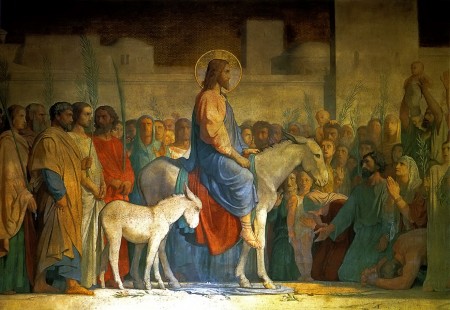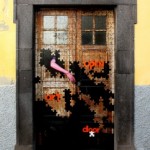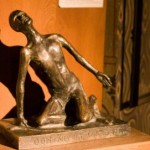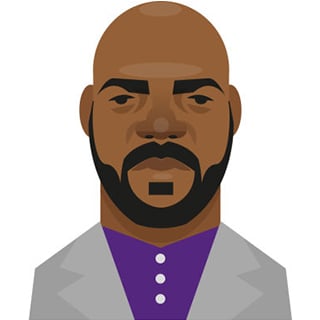He rides in straddling two donkeys, according to Matthew, one a colt, the other its mother. He planned this ‘entrance’: funny as a late night comic, awkward as a clown’s pratfall, not piously humble but mocking, like Katniss Everdeen in The Hunger Games, refusing to enter into the pomp and circumstance of the Games because she knows they are rigged. It is death she is challenging. And it is death Jesus is challenging, in the Jerusalem Games.
 There’s evidence now of two processions that day in Jerusalem. (see Marcus Borg and John Dominic Crossan: The Last Week.) Jesus’ was the counter-procession, stealing the pomp from Pilate’s ceremonial procession. The Roman battalion, solemnly advancing through the western Damascus Gate, on the Syrian Road. Awesome stallions. Clanging hooves against the paving stones. Gleaming metal lances. Swords, dirks, helmets. Polished leather armor, saddles, boots. Drums.
There’s evidence now of two processions that day in Jerusalem. (see Marcus Borg and John Dominic Crossan: The Last Week.) Jesus’ was the counter-procession, stealing the pomp from Pilate’s ceremonial procession. The Roman battalion, solemnly advancing through the western Damascus Gate, on the Syrian Road. Awesome stallions. Clanging hooves against the paving stones. Gleaming metal lances. Swords, dirks, helmets. Polished leather armor, saddles, boots. Drums.
Pilate was marching his men because the Jewish Feast Days were beginning, and that stirred a restlessness in the people. He was sending a message, any trouble would be crushed. The Pax Romana, Caesar’s peace, would be enforced.
At the Beautiful Gate, on the opposite side of town, coming in through an olive grove, rode Jesus, alone, sitting on a donkey, one leg draped over her colt, someone’s old cloak under him. Laughter and foolishness brought travelers together into a waving crowd, good naturedly throwing palm branches in the rutted path. This was the gate legend held was the one through which the Shekinah brought the Sabbath each Friday at sundown, and the gate through which the Messiah would one day come.
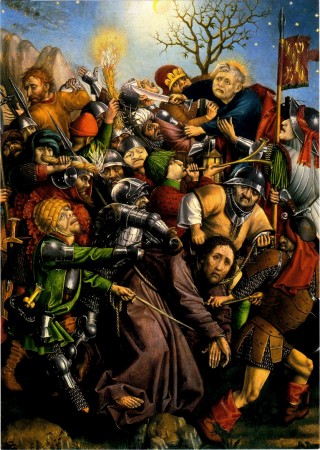 It was for this procession that they arrested him, scholars say. Whatever trouble he made among the sellers at the Temple was a Jewish problem, not a Roman one. But this counter-procession, this mockery of Pilate and Rome that drew a huge throng and filled the city with laughter, was intolerable.
It was for this procession that they arrested him, scholars say. Whatever trouble he made among the sellers at the Temple was a Jewish problem, not a Roman one. But this counter-procession, this mockery of Pilate and Rome that drew a huge throng and filled the city with laughter, was intolerable.
Who is this? the crowds asked, wanting to know the source of this rippling laughter, this derring-do.
When you want to call a dragon out of its cave, you can use many voices as your megaphone, their echoing laughter roaring its name for you. You can break solemn silence with laughter. Nothing will keep the dragon from coming out to see, Who dares to laugh at me? You can stand before the dragon, not in awe. And that will pierce it good as any sword.
Luke says Jesus stopped on the way in, to weep a little for the city, saying, If only you had known the way that leads to peace – but no, it is hidden from your sight. John says he had a wrenching break with Judas the night before. Matthew says the arrangements about the donkey were made in secret. There is a trail of tears and danger behind this entry, this sad and smiling man who takes no sword, no lance, no drum as he rides on to slay the Dragon.
 Hosanna! The crowds of travelling pilgrims shout, families, kids, grandparents, all on their way to Temple Days. But to whom are they shouting? Most don’t even know his name. He’s touched a dream they share, of a different time. Some want a Pilate with different politics. Some want the empire of their dreams. Some want a new Elijah, some a new Solomon. Some don’t know what they want, really. And nor do we. But who doesn’t want a little glory? Even the disciples are confused about what is happening, what Jesus is doing now.
Hosanna! The crowds of travelling pilgrims shout, families, kids, grandparents, all on their way to Temple Days. But to whom are they shouting? Most don’t even know his name. He’s touched a dream they share, of a different time. Some want a Pilate with different politics. Some want the empire of their dreams. Some want a new Elijah, some a new Solomon. Some don’t know what they want, really. And nor do we. But who doesn’t want a little glory? Even the disciples are confused about what is happening, what Jesus is doing now.
Most, if not all of them, will have no part in the crowd at Pilate’s porch a few days later, asking for Barrabbas to be freed. That was a hand-picked crowd, men only, inside a courtyard, probably paid (see The Last Week). So the old hymns we sing about the crowd being fickle are wrong. It was Pilate’ s soldiers that arrested Jesus, Pilate’s soldiers that carried out the execution.
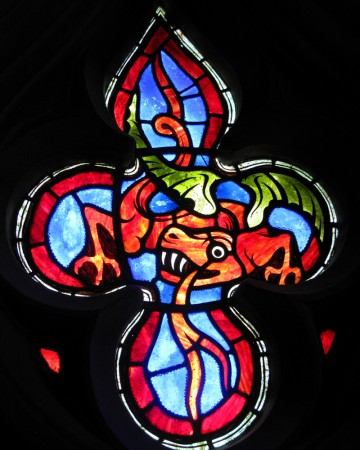 But the Dragon is more than Pilate and his Legion. The Dragon is larger than Caesar and his army. The Dragon is Human Fear, and Power not born of Love. The Dragon is kingdoms not made of grace and peace, but of dollars and resignation, ambivalence and bondage.
But the Dragon is more than Pilate and his Legion. The Dragon is larger than Caesar and his army. The Dragon is Human Fear, and Power not born of Love. The Dragon is kingdoms not made of grace and peace, but of dollars and resignation, ambivalence and bondage.
I came, he said in the beginning, to bring good news to the poor, release to prisoners and recovery of sight to the blind, to let the oppressed go free, and to proclaim God’s favorable time. Every day we wonder what he meant, and if it could possibly be enough.
Who is this? We still want to know. And we have a list of names, none of which honor what he said he came to do. Innocent Victim is not his name, he who chose his confrontations and forgave his persecutors. Unrecognized is not his name, when crowds shouted Hosannas. Betrayed is not his name when he taught that this is the Way to be Human. Perfect is not his name when he flaunted so many rules, cursed a fig tree, hung around with prostitutes, prayed to have his fate reversed, and in so many other ways was as fully human as we are. Without Sin is not the point he was making with his life.
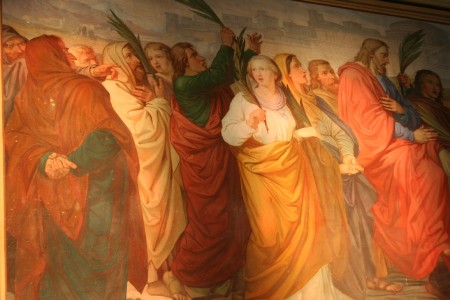 These names ring true: Jesus, Jew. Jesus, Jester. Jesus, Teacher. Jesus, Man of Sorrows. Jesus, Beloved. Jesus, Ark for the Poor of the World. Jesus, Shepherd. Jesus, Light. Jesus, remember me, when you come into your kingdom.
These names ring true: Jesus, Jew. Jesus, Jester. Jesus, Teacher. Jesus, Man of Sorrows. Jesus, Beloved. Jesus, Ark for the Poor of the World. Jesus, Shepherd. Jesus, Light. Jesus, remember me, when you come into your kingdom.
At the end, the Dragon’s Cave will be empty. Death will no longer breathe fire. And the end of the day will no longer be the day’s end.
Who is this?
__________________________________________________________
Illustrations:
1. Christ Entering Jerusalem. Vatican Art. Vatican website.
2. Roman legion, Freeze Frame from French TV film, All Roads Lead to Rome, the 1st show.
3. Capture of Christ, by Master of the Karlsruhe Passion, 1450, Cologne, Germany. Vanderbilt Divinity School Library, Art in the Christian Tradition.
4. Palm Sunday Procession, Port Vila, Vanuatu. Vanderbilt Divinity School Library, Art in the Christian Tradition.
5. Dragon, National Cathedral, Washington, Stained Glass. Vanderbilt Divinity School Library, Art in the Christian Tradition.
6. Jesus Entering Jerusalem. Parish Church of Zirl, Austria. Wikipedia Commons.

